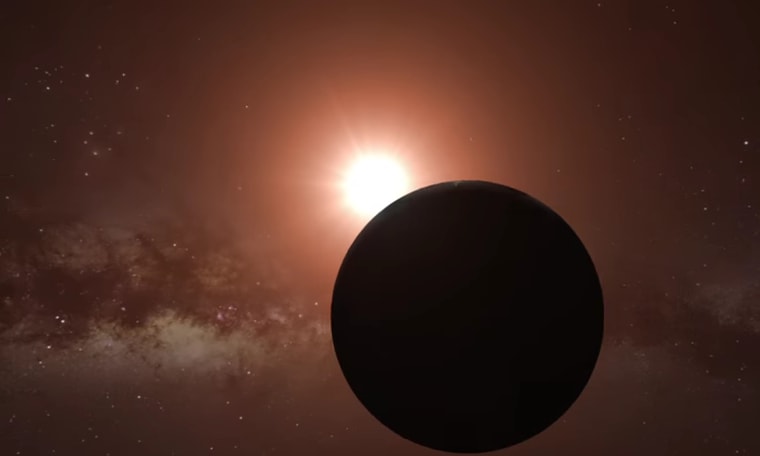We love outer space. Why wouldn't we? The endless mysteries. The vast light shows. But maybe the coolest part about space?
Extra-terrestrial life.
Aliens. Creatures from another world. What would they look like? How would they behave? And where would they live?
That last question is one of the biggest stumpers out there. Space researchers call it the search for an Earth-like planet. This means that it is a place that would have conditions similar to what we have here on Earth — the right temperature, atmosphere, surface, and elements for life to grow and evolve. Now scientists are saying that they've found one: Proxima B.
And it's right. next. door.
A-Proxima-tley next door, that is
Is this what it looks like on the surface of Proxima B? (Getty Embed)
Okay, yes, "right next door" in universe speak is still about 4.2 light years away from us. That's over 39 trillion kilometres (24.6 trillion miles). But it is the nearest Earth-like planet that we've found yet, as well as the nearest we'll likely ever find. Proxima Centauri, the star that Proxima B orbits, is the nearest star to our solar system.
It's no small thing for a planet to be able to host life. First off, it needs to be in orbit within the "habitable zone" of a star. This is the area around the star that is close enough to be warm and cozy for living things. It's also called "the Goldilocks zone" because just like the famous children's tale, this area isn't too cold and it isn't too hot. It's just right.
Of course, there are thousands of other factors that can determine whether or not a planet can support life as Earth does. Is the atmosphere thick enough to trap heat, but not too thick that it stops photosynthesis? Is the planet's orbit about the same distance away from the star at all times, or is it elliptical (which means it gets much farther away for a large part of the orbit)?
Red dwarf raises questions
On the right, you can see the habitable zone of Proxima Centauri (in green) and when Proxima B is in it. For comparison, the left side shows how close Mercury is to our more powerful Sun. Mercury is not in the habitable zone of our solar system. (Getty Embed)
Then there is the issue of the star, Proxima Centauri. It is what is known as a red dwarf. These are the most common stars in the Milky Way and they live for trillions of years. Sounds great, except that they're also much cooler and smaller than our own star, the Sun. To be in a red dwarf's Goldilocks zone, a planet would have to be so close that it would likely be tidally locked (this means that it would not rotate as it orbited). So one side would always be day, the other side always night. Or to go even further, one side very cold, the other side extremely hot. Doesn't sound so warm-bowl-of-porridge after all, does it?
If your head is already spinning, that's fine. Many scientists have dedicated their lives to solving the problem of what makes an Earth-like planet work, and there is still so much they don't understand. Some scientists argue that a planet like Proxima B could still support life even if it was tidally locked. (They say that the right atmosphere would trap and move heat evenly around the entire planet.) In the end, there's only so much guessing and theorizing anyone can do from all the way down here on Earth.
If only they could get a closer look...
Microships of the near future
Philanthropist (a person who gives money to causes) Yuri Milner holds the StarChip. This proposed spacecraft would be the lightest, smallest, fastest probe ever. (Getty Embed)
Which brings us to maybe the coolest thing about all of this. Remember when we talked about how far away Proxima Centauri and Proxima B were from Earth? 4.2 light years. It would take our fastest spacecraft thousands of years to complete a journey that long. Impossible, right? Well, what if we said that a spacecraft could make the journey in 20 to 30 years instead? That is what the Breakthrough Starshot project is all about. (Hold tight here, because if what we were talking about earlier didn't blow your mind, this will...)
The idea of Starshot is to create nanocrafts ("nano" means tiny) called StarChips that would measure only centimetres in length and weigh a few grams (like postage stamps). The tiny StarChip would have large, ultra-thin "light sails" that would capture energy from a super-powered laser. This laser would shoot out a beam that the nanocrafts would ride to its destination. Because the StarChips are small and cheap, missions would send hundreds of nanocrafts at once to the same target, one after the other. Researchers estimate that the ships could travel at around 20% of the speed of light (around 160 million km/h or 100 million miles an hour). If aimed at Proxima Centauri (which is one of the first proposed targets for the project), it would arrive about 20 to 30 years after it was launched. It would then be able to send back information (pictures and other data) in a little over 4 years after that.
Whoa. What does it all mean?!?
It means that while human space travel of that distance is still a long ways away, you could someday see up-close images of a life-bearing planet from another solar system. Check out this video, which shows how a nanocraft would be launched, fly through space, and then relay information back to Earth.
 Is there really another planet out there like Earth? Scientists think so. (Screenshot courtesy of Nature magazine)
Is there really another planet out there like Earth? Scientists think so. (Screenshot courtesy of Nature magazine)










A M A Z I N G
awesome and cool I never knew this was there